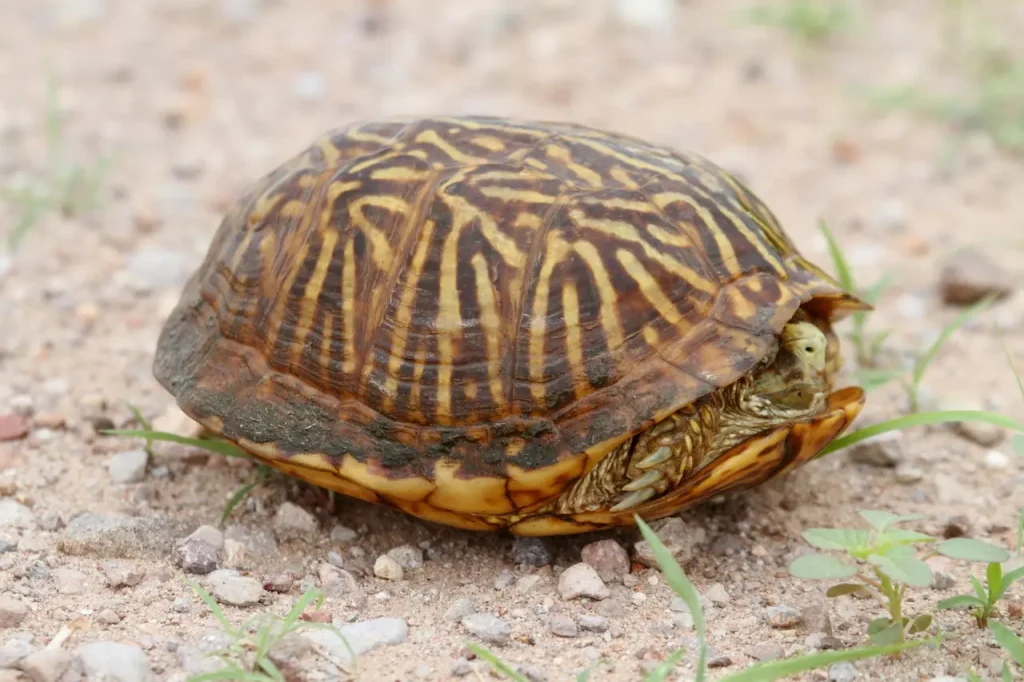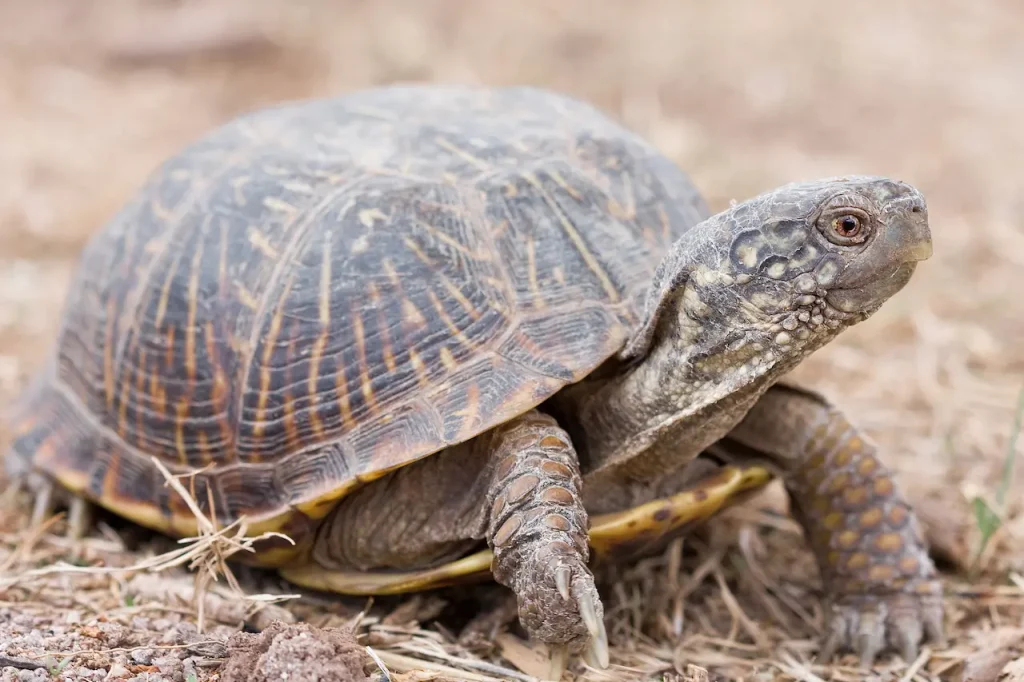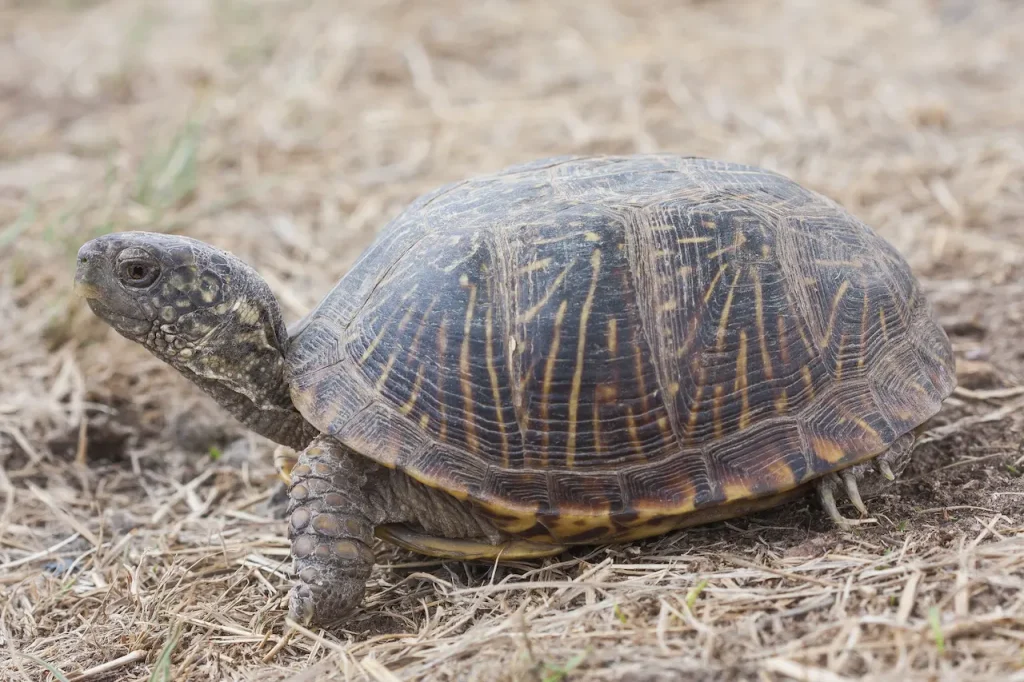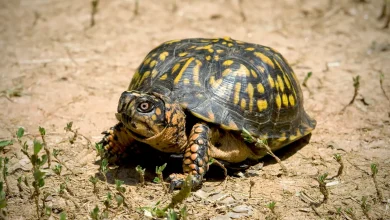Table of Contents
The Desert Box Turtle
The desert box is one of two subspecies of the Western Box turtle (Terrapene ornata)
The two subspecies are:
Desert box turtle, Terrapene ornata luteola (Smith & Ramsey, 1952)
Ornate box turtle, Terrapene ornata ornata (Agaxxiz, 1857)
The desert box turtle is similar in appearance to the ornate box turtle. However, the desert box turtle is more yellowish. It is also more adapted to life in arid conditions than the ornate box turtle.

Desert Box Turtle Distribution
Desert box turtles are endemic to the southwestern U.S. including west Texas, New Mexico, and Arizona. They can also be found in northern Mexico as far south as Sonora and Chihuahua.
Desert Box Turtle Habitat
The desert box turtle is found in regions that are arid, semi-arid, grasslands, and prairies. It needs soil that is easy to dig for nesting and hibernating.
You can often find the desert box turtle in prairie dog towns.
The desert box turtle is only active in the summer months when the humidity is very high.
Body
The desert box turtle has a hinged shell similar to other box turtles that allows it to completely close its shell to protect itself.
Desert box turtles have two different types of colourations. One is patterned and the other is unpatterned. The patterned turtle has a brown to pale carapace and thin yellow lines. The unpatterned type is straw-coloured or greenish. This type is less common and has no striping.
The body and legs are dark-coloured with yellow markings.
The average length is 35 centimetres.
Sexing a Desert Box Turtle
The male desert box turtle has red eyes and the female has brown eyes.
Also, the male turtles usually have one back toe that turns inward and thicker tails.
What does a Desert Box Turtle Eat?
The desert box turtle eats a diet mostly of insects. But it will also eat plants, berries, and animal tissue. It will search under cow dung to find insects such as beetles.
How old can a Desert Box Turtle get?
A desert box turtle is not an adult until it is ten years old. Some can live as long as fifty years or more with proper care.
It is not possible to tell a turtle’s age by counting the growth rings on its shell. The rings show the rate of growth so they don’t form based on the passage of time. They may have three or four rings when they’re younger and growing quickly. Many wild turtles stop growing new rings after the age of twenty.

Keeping Desert Box Turtles as pets
Desert box turtles make interesting pets and many people enjoy watching them and learning their habits.
However, like most turtles, if they are properly cared for they can live many more years than a cat or dog. Be sure you are committed to learning about and caring for your new pet.
It is never a good idea to take a turtle from the wild and make it a pet. Wild turtle populations are shrinking and it’s best to leave it to reproduce and add to the natural population. Wild turtles do no always adapt well to life in captivity.
Also, if you find adult turtles for sale in a pet store ask where they were obtained. They were often caught in the wild and will have the same problems we just discussed.
One of the best ways to obtain a desert box turtle is to call your local humane society and see if they have any for adoption. Not all pet owners keep their commitments to their pets and give them up for adoption.
Joining turtle clubs is another good way to find out where to obtain turtles that have been bred in captivity and therefore will make good pets.
These clubs can also make a good resource for learning about how to take care of your new pet. Online forums are another way to share information and ask questions regarding the best way to care for your turtle.
If you purchase a new turtle you should always keep it quarantined from your current pet turtles for several months. This is the only way to be sure it doesn’t have some type of bacterial infection that can be spread to another turtle. You should consider taking new pets to the vet for a check-up if possible.
Housing a Desert Box Turtle
When housing a Desert Box Turtle it’s important to remember that they are cold-blooded or ectothermic. This means they cannot heat their body by their metabolism. When they’re cold they lie in the sun. If they’re warm they’ll find shade. For this reason you’ll need to provide some sort of heat for your turtle. Two UVB bulbs are usually sufficient.
A desert turtle will enjoy an outside enclosure or a large inside space. Your desert box turtle must have some stimulation in its environment. For this reason, you might want to consider a large Rubbermaid tub for housing as opposed to a small aquarium.
Peat moss, sand, and pea gravel makes a good base for the turtle’s habitat. A rock that the turtle can climb on is also good.
If you use an outside enclosure it’s good to have a small area where the turtle can swim and to keep the area humid. You should also provide a place where the turtle can rest in the shade
Your turtle can be kept in a small glass aquarium but it’s not a very stimulating area and doesn’t give your pet much room for movement. Also, with a glass aquarium the turtle will often try to break through the glass to reach areas that it can see. This is why Rubbermaid tubs and wooden enclosures are ideal.
Desert box turtles can dig under enclosures and even climb so if you house your turtle outside it needs to be secure.
It’s important that any outdoor area needs to be protected from predators such as dogs.
Don’t try to mix turtles from different species together in the same housing. Asian and American box turtles mustn’t be housed together.
Remember: have the turtle’s home set-up before you bring him home.
Feeding a Desert Box Turtle
The desert box turtle enjoys live food such as worms, slugs, grasshoppers and other insects.
It is not a good idea to feed a turtle cat food. It is too high in protein and can cause obesity, shell deformities and other health problems.
Parasites
If you keep your turtle inside you probably won’t have a problem with parasites. But if you buy a turtle that was caught in the wild you might discover it has a problem with parasites.
There are external parasites called ectoparasties. These are found on the shell or skin of the turtle. Internal parasites or endoparasites can be found in the lungs, blood, liver or gut.
If you suspect your turtle has parasites it’s always a good idea to take him to a veterinarian that is familiar with treating reptiles.

References
- Germano, D. J. y Nieuwolt, D. P. M. 1999. Terrapene ornata luteola (Desert box turtle). Homing behaviour. Herpetological Review. 30 (2): 96.
- Rabb, George B. 1961. Natural history of the ornate box turtle, Terrapene ornata ornata Agassiz. Copeia 1961 (1): 123-124
- Philippen, H.-D. 2004. Box turtles of the genus Terrapene. Reptilia (GB) (32): 12-18
- Germano, D. J. 1999. Terrapene ornata luteola (Desert Box Turtles). Attempted Predation. Herpetological Review. 30 (1): 40-41.
- Smith, H.M. and Ramsey, L.W. 1952. A new turtle from Texas. Wasmann Journal. Biol., 10 (1): 45-54
- Iverson, J. B. 1992. A Revised Checklist with Distribution Maps of the Turtles of the World
- Collins, J. T. 1990. Standard Common and Current Scientific Names for North American Amphibians and Reptiles, Third Edition. ii + 41



